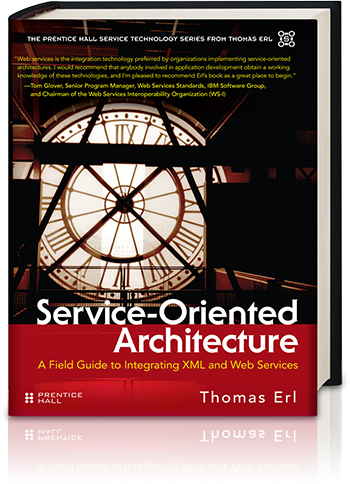The following changes apply to the 1st and 2nd printing (3rd and higher printings contain these changes):
Grammar, Wording, and Formatting Corrections:
Page 70, last item in bulleted list below Example 3.6
Instead of “…information to underlying operation” it should be “…information to the underlying operation”
Also, the opening and closing <service> tags in Example 3.6 should not be there.
Page 72, last paragraph
Instead of “…standards, are covered in Chapter 4.” it should be “…standards, which are covered in Chapter 4.”
Page 120, bottom paragraph
Instead of “In the scenario portrayed in (Figure 4.23), for example…” it should be “In the scenario portrayed in Figure 4.23, for example…”
Page 136, last paragraph, last sentence
Instead of “Figure 5.2 illustrated… “ it should be “Figure 5.2 illustrates… “
Page 218, third paragraph (“External Services”)
Instead of “Types of external service more…” it should be “Types of external services more…”
Page 224, paragraph after Figure 6.31
Instead of “Using a parameter-drive design…” it should be “Using a parameter-driven design…”
Page 228, Section 6.6.1, second paragraph
Instead of “…internal server boundaries look for ways…” it should be “…internal server boundaries, look for ways…”
Page 237, second NOTE section
Instead of “…an understanding their differences.” it should be “…an understanding of their differences.”
Page 291, Section 8.2.3, last paragraph
Instead of “…component then allows the management…” it should be “…component then allows for the management…”
Pages 370-377
Title Outline Correction. Three of the headers in these pages should have been sub-headers under the 10.3 parent header, as follows:
– Section 10.4 should be 10.3.1.
– Section 10.5 should be 10.3.2.
– Section 10.6 should be 10.3.3.
Page 345, Table 9.10, “Performance” row, second column
Incorrect hyphenation. Instead of “runt-ime” it should be “run-time”.
Page 504, Section 14.3.1, “So, why bother?” Sub-Section
Instead of “…it can easily be combined with the Internal phase, which broadens the scope dramatically” it should be “…it can easily be combined with the Internal phase, which does not broaden the scope dramatically”.
Page 513, “Technologies” bullet list
Instead of “- XSLT for aesthetic structural transformation” it should be “- XSLT for aesthetic and structural transformation”.
General:
– www.serviceoriented.ws and www.specifications.ws should not be hyphenated (Some URLs were accidentally hyphenated during the import of the original manuscript into Framemaker.)
– The abbreviation WSDL represents the Web Services Description Language. (A last minute global search and replace caused this error.)
– When referencing the W3C specification, “XML-Digital Signatures” should be “XML-Signature”.
Content Corrections:
Page 194, Summary of Key Points section
The following two bullets are missing:
– The three fundamental service models are utility, business, and controller services.
– A Web service can belong to more than one service model.
Updates (revisions made to reflect industry changes):
– The term “service assembly” has been replaced with the term “service composition”.
– Page 51, second last paragraph: Instead of “…an SOA promotes the use of a discovery mechanism for services via a service broker or discovery agent.” it should be “…the design principles introduced by SOA (known as the principles of service-orientation) emphasize reuse, statelessness, autonomy, abstraction, discoverability, loose coupling, and composability.”
– See www.serviceorientation.com for more information regarding service-orientation principles.
– Pages 69-70, examples on these two pages are based on the WSDL 1.2 specification. WSDL 2.0 introduces the root <description> element which (when used) replaces the <definitions> element used in these examples.
The following changes apply to the 1st, 2nd, and 3rd printing (4th and higher printings contain these changes):
Grammar, Wording, and Formatting Corrections:
Page 2, Section 1.1, second paragraph
Instead of “…its importance cannot be understated.” it should be “…its importance cannot be overstated.”
Additional changes:
Page 52, Figure 3.3
The symbol representing the presentation layer should be labeled with “presentation” instead of “presentanion”.
Page 85, Example 3.15
Since this book was published, Microsoft has taken down its test UDDI registry. The test.uddi.microsoft.com URL is therefore no longer working and the value in the discoveryURL element of this example is not currently valid.


